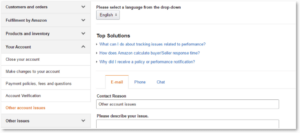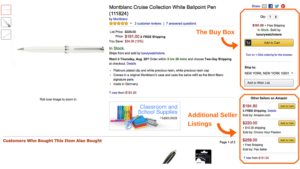How to Delete an Amazon Review…And Why You Shouldn’t

When you buy something through one of the links on our site, we may earn an affiliate commission.
If you're wondering how to delete an Amazon review, you're not alone. Unfortunately, for thousands of Amazon sellers, the number of bad reviews is increasing year over year.
What was once a mild annoyance is now fair game for a blistering one-star review, accusing the seller and the product of being frauds. Storefronts are closing, products are returned, and the entire e-commerce sector is in danger of crashing.
Okay, maybe it's not that bad, but the basic premise is true. More people are leaving negative reviews on Amazon than ever before, forcing more sellers to wonder how to delete an Amazon review that they disagree with.
(As a bit of good news, an overwhelming number are still positive reviews, so don't give up hope on humanity just yet).
Can you delete an Amazon review that was left by a customer? And, perhaps just as important, would you even want to?
In a rush?
If you're concerned about reviews or growing your business as an Amazon seller, you should definitely consider Jungle Scout (it's also the best Chrome extensions for Amazon seller)! It's a massive toolbox to help you grow, but one feature in particular is worth noting in this article: Amazon Review Automation Tool. It's a first of its kind, Amazon ToS-approved automation tool that helps make it easier than ever to set up and customize review request to your desire.
Check Out Jungle Scout HereContents
Can I Legally Delete an Amazon Review?
The short answer to that question is no, you cannot.
Amazon doesn't allow for their sellers to just delete reviews at will; if they did, the whole system would collapse.
Product listings would be full of five-star reviews talking only about how great the item is, with a suspicious lack of information as to its flaws.
Per Amazon's own terms of service, the only way you can legally get a review removed from your product listing is if it's in violation of their review policy. This includes such nefarious actions as:
- Any positive review by someone who has a financial interest in the product.
- Reviews by the product's manufacturer that is masquerading as an everyday shopper.
- Several negative reviews from the same customer (on the same listing).
- Any review that is bought in any fashion.
- Negative reviews from competitors.
- Positive review swaps with other sellers
Short of any of those situations developing, having a bad review removed is virtually impossible according to Amazon's review guidelines, no matter how much you would like it to be gone.
But assuming one of those above scenarios has taken place, you have a few different options at your disposal.
Report Abuse
Below every customer review is a tiny little button where you can report abuse on any illegal reviews, whether they're on your listing or not. This automatically flags the review in Amazon's system for a moderator to inspect manually.
As a side note, you can also upvote reviews that are particularly helpful. This gives more weight to reviews that you think others might benefit from and improves your own reviewer's standing in the eyes of Amazon.

Send an Email
If you spot a product review that you feel goes against Amazon's TOS, and want to report abuse the old fashioned way, snap a screenshot and send it via email directly (email address may change per country). Make sure you include the ASIN, as well as the time, date, and name of the reviewer, along with a direct link to the negative Amazon review.
Contact Seller Support
Sometimes, especially if your product is successful, you may be the victim of a coordinated attack by your competitors. Your Seller Central account offers a direct line to their support team (both phone and email), where you can contact them about the activity.
Generally, responses take a day or two, but they've been known to side on behalf of the Amazon seller if it can be proven that these negative reviews on Amazon are competitive-driven.

What is the Impact of Negative Reviews?
Once you've decided what to sell on Amazon, reviews become a reality. Amazon considers four and five-star to be positive reviews, three stars to be neutral, and one and two-star reviews as negative feedback.
Sellers, on the other hand, often shoot for five stars or bust. Anything less than that is taken as a slight.
Regardless, the impact of a one-star product review goes well beyond the psychological. It can have a direct impact on your business's bottom line, so it needs to be addressed ASAP.
Loss of Revenue
Studies have shown that a single negative review can affect your sales numbers by as much as 22%. Three negative reviews on Amazon decrease sales by as much as 60%, while multiple negative reviews or more than four can cost 70% of your revenue.
Of course, a lot of this is relative. A product with thousands of four and five-star reviews won't be affected as much by a single negative review, but a new product listing will and so wanting to remove multiple negative reviews is only natural.
For that reason, it's imperative that your launch strategy includes a team of beta testers that can vouch for your new product's viability.
This same phenomenon is seen in the brick-and-mortar world as well. A Harvard Business Review study found that a one-star increase on Yelp can translate to nearly 10% of additional business.
Monitor those reviews because they're the very lifeblood of your online business.
Amazon Algorithm Shift
Although nobody's quite sure how it all works, it's obvious that Amazon has a plan for what products to show to what people. If a person types in “banana peeler” — and, honestly, who doesn't? — it'll show the products that have the best reviews to that Amazon customer.
Why? Because social proof dictates that this item serves the needs of the customer the best. Low rankings are an indication that the product itself is poor, and will usually be relegated to page nine.
Degraded Business Reputation
Your individual Amazon seller feedback is calculated over different lifecycles: 30 days, 90 days, 365 days, and lifetime. That feedback is determined by things such as customer response times, shipping and delivery accuracy, and similarity between product and description.
While your individual product reviews are important, many Amazon sellers are convinced that the seller feedback is a very close second. The better the seller feedback, the more likely you are to win the Buy Box, which gets the vast majority of the sales from that product.
This doesn't matter as much if you're planning on doing your own product via Amazon FBA, but it's absolutely vital for thrift arbitrage and more competitive products.

Can Negative Reviews Actually Be Helpful?
Just because you received a bad product review doesn't mean that the customer hates you or the product. In fact, in a few ways, having negative feedback can actually help your sales. You'll still want to mitigate them whenever possible, but don't be alarmed if a few pop up from time to time.
Negative Reviews on Amazon Signal Honesty
No third-party seller in their right mind would dream of leaving a one-star review on their own product. They're the founder, after all, so why would they denigrate their own creation?
This is exactly the mindset that customers have as they approach your product listing. While they obviously gravitate towards products that are well-regarded by their fellow customers, nobody trusts a product that only has positive reviews.
The main reason for this is the reputation that Amazon has gained of enabling review scammers to flood their storefronts. Fake reviews have (unethically) helped thousands of sellers gain footholds for years, and try as they might, Amazon struggles to remove them (but there are lots of great Amazon fake review checkers out there to help both shoppers and sellers spot them).
Signs of review scammers are pretty obvious:
- Lack of “meat” inside the review. If all the review says is how much they “loved the product,” that's a sign of a low-effort and possibly fake review.
- If the review advertises a competing product instead.
- A lot of positive reviews posted on the same day. This usually means that these reviews have been bought in bulk.
If you notice any of the above signs (or have suspicions of your own), it doesn't hurt to reach out to customer support to verify. With hundreds of millions of products on their website, Amazon needs all the help they can get.
Negative Reviews Give Important Feedback
Part of the reason sellers rely on beta testers so heavily is because they provide crucial information to the inner workings of a product before it goes to market.
If there's something wrong with a device, you need to know about it from a small group of people before everyone blasts you on the review board and sinks the product.
It can be easy to take negative reviews personally but not all negative reviews are harmful – you can look at them as an opportunity to improve. The customer must've initially liked quite a bit about it (or else they wouldn't have purchased it), and they want it to be as good as it can be.
Furthermore, scoping out the negative Amazon reviews on your competitors can give you quite an edge. If you sort by negative reviews on a listing, you can see all the things people wished that product would be. Implementing a few of their suggestions for your own item can set you apart from the crowd.
Negative Reviews Prove Sales Velocity
Yes, everyone hates and wants to remove negative reviews. But you know what sellers hate more? No reviews.
Reviews of any kind are proof that something on your site is working. Maybe it's the blurb, the product images, or the ads, but something is causing that item to move off of the shelves. So even negative Amazon reviews can be a good thing.
Truthfully, mixed reviews are better than no reviews. You have money in your pocket, increased brand awareness, and proof that some part of the customer segment is responding. You can work with that.
How Do I Manage Negative Reviews?
Everyone gets negative reviews at some point. The question is, how do you respond?
Though your first instinct may be to shake your fist at the heavens and curse the Amazon customers who had the gall to insult your creation, take a moment to collect yourself.
By responding appropriately, you can take a negative situation (no pun intended) and turn it into something positive – maybe even more positive reviews.
Respond to the Feedback
Amazon allows sellers to respond to individual customers instead of letting them remove negative reviews. This didn't use to be the case; in years past, you had to put on your detective's hat and sort through order numbers. Even then, it was hit or miss at best and was highly discouraged by Amazon.
If you spot negative Amazon reviews, look to the right and find the button that says “Contact Customer.” This will bring up a form email that you can send directly to them, asking them what was wrong with the product (not berating them for their ignorance).
The content of the email should be professional and almost obnoxiously kind. Tell them that you appreciate their honesty, ask them for specifics (if they didn't give any), and promise to improve on it.
You can ask them to change their bad review if you want or even edit review, but that's shaky and can lead to false pretenses.
At the very least, people want to be seen, so make sure they know that you recognized their unhappiness and strive to make it right.

Improve on Suggestions
If the customer left any kind of constructive feedback, take it to heart. Go back to your manufacturer and request improvements in quality control. Address shipping issues with Amazon. Check the listing to make sure it's accurate.
Once you've made the suggested improvements (if you deem them valid), consider updating your product listing to address the issues.
You might also contact the customer who left the bad review and tell them you've fixed the problems, and if possible, offer a replacement.
Request Changes
Assuming that the customer's bad review was genuinely unfair in every sense of the word, it's a good idea to reach out and ask them to change it. Perhaps there was a misunderstanding and you can resolve it in some way.
Negative reviews from competitors, on the other hand, need to be taken up directly with Amazon itself. Don't waste your breath trying to convince shady sellers who have nefarious tactics; go to the top itself and ask customer service to take action.
Either way you choose, remember to tread carefully. Negative reviews are already left by upset individuals, so choose your words carefully and engage in meaningful dialogue when looking into how to delete an Amazon review.
Conclusion
Every seller, at some point, will wonder how to delete an Amazon review, but not every seller will learn from it. Those that do have the opportunity to set themselves apart in a very crowded marketplace, and also build a strong, loyal following from customers.
Brand-building is made up of little moments like these, and how you respond makes all the difference in the world.
Many Amazon FBA business owners have found Jungle Scout to be a must-have tool for all sorts of reasons – including in the quest for more reviews. It not only helps you with niche and product research, product listing optimization, and countless other features – but it also lets you maximize your product review potential with its Amazon terms of service-approved review request solution.
It automates the entire process and helps you sell more. And as a Niche Pursuits reader you can get all of Jungle Scout's features with a 30% discount!
Get 30% Off Jungle Scout Here!Want to learn step-by-step how I built my Niche Site Empire up to a full-time income?
Yes! I Love to Learn
Learn How I Built My Niche Site Empire to a Full-time Income
- How to Pick the Right Keywords at the START, and avoid the losers
- How to Scale and Outsource 90% of the Work, Allowing Your Empire to GROW Without You
- How to Build a Site That Gets REAL TRAFFIC FROM GOOGLE (every. single. day.)
- Subscribe to the Niche Pursuits Newsletter delivered with value 3X per week
My top recommendations


















